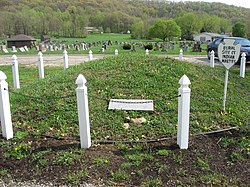Nonresistance
Nonresistance (or non-resistance) is "the practice or principle of not resisting authority, even when it is unjustly exercised".
Sometimes non-resistance has been seen as compatible with, even part of, movements advocating
History

The term nonresistance was later used to refer to the
Nonresistance played a prominent role in the
Leo Tolstoy,[4] Adin Ballou,[5] and Mahatma Gandhi[6] were notable advocates of nonresistance. However, there were variations between them. Gandhi's Satyagraha movement was based on a belief in resistance that was active but at the same time nonviolent, and he did not believe in using non-resistance (or even nonviolent resistance) in circumstances where a failure to oppose an adversary effectively amounted to cowardice. 'I do believe,' he wrote, 'that where there is only a choice between cowardice and violence, I would advise violence.'"[7]
Christian theology

| Part of a series on |
| Anabaptism |
|---|
 |
|
|
Christian nonresistance is based on a reading of the Sermon on the Mount, in which Jesus says:
You have heard that it was said, ‘An eye for an eye and a tooth for a tooth.’ But I say to you, Do not resist an evildoer. But if anyone strikes you on the right cheek, turn the other also; and if anyone wants to sue you and take your coat, give your cloak as well; and if anyone forces you to go one mile, go also the second mile. Give to everyone who begs from you, and do not refuse anyone who wants to borrow from you.
— Matthew 5:38-42, NRSV
Members of the
The word “nonresistance” is taken from Matthew 5:39, “do not resist him who is evil.” It is strictly a New Testament (NT) doctrine, intended for the followers of Jesus, with a specific purpose during this NT church age. When we submitted ourselves to Jesus as Lord, we became citizens of the Kingdom of God, and accept the commands of the NT and the example of Christ as our rule for living. The NT forbids the Christian from retaliation and revenge but instead charges us to pray, bless, and do good to those who would harm us. We suffer the spoiling of our possessions for Christ’s sake joyfully. We preach the Good News of the Gospel, which is a message of peace—reconciliation is possible between God and man. Jesus came not to resist and judge evil humanity, nor to set up an earthly government, but to willingly and peacefully lay down His life for His enemies. As followers of Christ, we are to follow His example so that our life becomes a living sermon, pointing to the life and works of Jesus. This is the purpose of non-resistance. Therefore, it is not a way of life to be foisted on those who are not the disciples of Jesus, because it is for the Church, a heavenly institution, established by God’s redeeming grace. Nor do we expect it of the state, which is a worldly institution, functioning under God’s conserving grace. The country is presently ordained by the sovereign God to carry the sword to keep order and execute the wrath of God, but nowhere in the NT are the Disciples of Jesus given a part in this service. We are called to walk as Jesus walked and to go into the nations, making disciples, teaching them his commands, and trusting in God for our protection. The state and the Church are two separate institutions, differing in their purpose, character, and destiny.[2]
The
One soldier taunted an Indian by pretending to offer him his hatchet with the words, "Strike me dead!" When the man answered, "I strike no one dead!" the soldier swung at the Indian and "chopped his arm away." All the while, the Indian kept singing [a Christian hymn] "until another blow split his head."[11]
To illustrate how nonresistance works in practice,
The path shown by Jesus is a difficult one that can only be trod by true martyrs. A "
war on terror."[12]
Author James R. Graham wrote, "The Christian is not a pacifist, he is a non-participationist."[13]
A main application of this theology for nonresistant Christians is to practice
See also
- Christian anarchism
- Christian pacifism
- Christian Peacemaker Teams
- Civil resistance
- John Howard Yoder
- Nonviolence
- Nonviolent resistance
- Nonviolent revolution
- Passive obedience
- Peace churches
- Turn the other cheek
- Tolstoyan
Footnotes
- ^ "nonresistance". Oxford English Dictionary (Online ed.). Oxford University Press. Retrieved 8 April 2011. (Subscription or participating institution membership required.)
- ^ a b c Long, Steve. "The Doctrine of Nonresistance". Pilgrim Mennonite Conference. Retrieved 20 May 2022.
- ^ David Blight, Frederick Douglass: Prophet of Freedom, Simon and Schuster, 2018. Chapter 8.
- ^ Tolstoy, Leo. The Kingdom of God is within you. 1893. [1], etc.
- ^ Ballou, Adin. Christian Non-Resistance in all its important bearings, illustrated and defended (1846). Providence; Blackstones Ed., 2003, 190 pp. [2]; Ballou, Adin. Christian non-resistance in extreme cases. 1860. [3]; Ballou, Adin. Non-Resistance in relation to human governments. [4], etc.
- ^ Ramachandra Guha, Gandhi before India, Penguin 2013
- ^ R. K. Prabhu & U. R. Rao, editors; from section “Between Cowardice and Violence,” of the book The Mind of Mohandas Gandhi, Ahemadabad, India, Revised Edition, 1967.
- ISBN 9781610979085.
- Church of God. pp. 5–9. Retrieved 20 May 2021.
- ISBN 978-1-62376-034-2.
- ISBN 978-0-8122-0379-0.
- ^ Christoyannopoulos, Alexandre (April 2008). "Turning the Other Cheek to Terrorism: Reflections on the Contemporary Significance of Leo Tolstoy's Exegesis of the Sermon on the Mount" (PDF). Loughborough University Institutional Repository. pp. 41–42.
- ^ Graham, James R., Strangers and Pilgrims, The Church Press, Glendale, California n.d., p. 35
- ISBN 978-0-7748-1117-0.
References
- NonResistance.org
- The Doctrine of Nonresistance in Anabaptist Theology - Pilgrim Mennonite Conference
- ISBN 0-691-02281-X.
- The Principle of Nonresistance - written in 1927 by John Horsch, a Mennonite historian and church leader.
- Nonresistance - article in the Global Anabaptist Mennonite Encyclopedia
- Tolstoy on nonresistance
- Tolstoy's Legacy for Mankind: A Manifesto for Nonviolence, Part 1
- Tolstoy's Legacy for Mankind: A Manifesto for Nonviolence, Part 2
